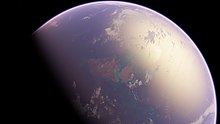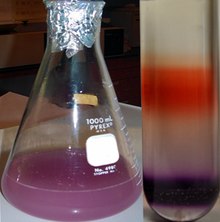| This article needs additional citations for verification. Please help improve this article by adding citations to reliable sources. Unsourced material may be challenged and removed. Find sources: "Purple Earth hypothesis" – news · newspapers · books · scholar · JSTOR (August 2023) (Learn how and when to remove this message) |


The Purple Earth Hypothesis (PEH) is an astrobiological hypothesis, first proposed by molecular biologist Shiladitya DasSarma in 2007, that the earliest photosynthetic life forms of Early Earth were based on the simpler molecule retinal rather than the more complex porphyrin-based chlorophyll, making the surface biosphere appear purplish rather than its current greenish color. It is estimated to have occurred between 3.5 and 2.4 billion years ago during the Archean eon, prior to the Great Oxygenation Event and Huronian glaciation.
Retinal-containing cell membranes exhibit a single light absorption peak centered in the energy-rich green-yellow region of the visible spectrum, but transmit and reflect red and blue light, resulting in a magenta color. Chlorophyll pigments, in contrast, absorb red and blue light, but little or no green light, which results in the characteristic green reflection of plants, green algae, cyanobacteria and other organisms with chlorophyllic organelles. The simplicity of retinal pigments in comparison to the more complex chlorophyll, their association with isoprenoid lipids in the cell membrane, as well as the discovery of archaeal membrane components in ancient sediments on the Early Earth are consistent with an early appearance of life forms with purple membranes prior to the turquoise of the Canfield ocean and later green photosynthetic organisms.
Evidence
| This section needs expansion. You can help by adding to it. (July 2023) |
The discovery of archaeal membrane components in ancient sediments on the Early Earth support the PEH.
Modern examples of retinal-based photosynthesis
An example of retinal-based organisms that exist today are photosynthetic microbes collectively called Haloarchaea. Many Haloarchaea contain the retinal derivative protein bacteriorhodopsin in their cell membrane, which carries out photon-driven proton pumping, generating a proton-motive gradient across the membrane and driving ATP synthesis. The process is a form of anoxygenic photosynthesis that does not involve carbon fixation, and the haloarchaeal membrane protein pump constitutes one of the simplest known bioenergetic systems for harvesting light energy.
Evolutionary history
| This article needs additional citations for verification. Please help improve this article by adding citations to reliable sources. Unsourced material may be challenged and removed. Find sources: "Purple Earth hypothesis" – news · newspapers · books · scholar · JSTOR (April 2024) (Learn how and when to remove this message) |
Microorganisms with purple and green photopigments frequently co-exist in stratified colonies known as microbial mats, where they may utilize complementary regions of the solar spectrum. Co-existence of purple and green pigment-containing microorganisms in many environments suggests their co-evolution.
It is possible that the Early Earth's biosphere was initially dominated by retinal-powered archaeal colonies that absorbed all the green light, leaving the eubacteria that "lived in their shadows" to evolve utilizing the residual red and blue light spectrum. However, when porphyrin-based photoautotrophs evolved and started to photosynthesize, which included both the primitive purple bacteria using bacteriochlorophyll and cyanobacteria using chlorophyll, highly reactive dioxygen was released as a byproduct of water splitting and started to accumulate, first in the ocean and then in the atmosphere. Over the course of a billion years, large enough quantities of oxygen had been produced, the reducing capabilities of chemical compounds on the Earth's surface were depleted, and the once-reducing atmosphere eventually became a permanently oxidizing one with abundant free oxygen molecules — an event known as Great Oxygenation Event. This coincided with a 300 million year-long global ice age at beginning of the Proterozoic known as the Huronian glaciation (which might also have been partly caused by the oxidative depletion of the atmospheric methane — a powerful greenhouse gas — due to the Great Oxygenation) and devastated the anaerobic biota, leaving the niches open for eubacteria that evolved antioxident capabilities (both the aerobic proteobacteria and the photosynthetic cyanobacteria) to exploit and prosper. This also forced the surviving anaerobes to either live only in anoxic waters and deep sea oxygen minimum zones, or adapt a symbiotic life among aerobes (whose colonies would sometimes consume enough free oxygen to create pockets of hypoxia where anaerobes can thrive), which might have paved way for the long-term endosymbiosis between anaerobic archaea and aerobic eubacteria (which evolved into mitochondria) that enabled eukaryotes to evolve.
However, the porphyrin-based nature of chlorophyll had created an evolutionary trap, dictating that chlorophyllic organisms cannot re-adapt to absorb the energy-rich and now-available green light, and therefore ended up reflecting and presenting a greenish color. The subsequent success of more advanced chlorophyllic organisms (particularly green algae and early plants) in terrestrial colonization created an overall green biosphere all over Earth.
Implications for astrobiology
Astrobiologists have suggested that retinal pigments may serve as remote biosignatures in exoplanet research. The Purple Earth hypothesis has great implications for the search for extraterrestrial life. Historically, scientists sought out planets reflecting light in the green-yellow range as possible hosts to photosynthetic organisms, due to the implied presence of chlorophyll. The hypothesis suggests that search methods should be expanded to planets reflecting blue and red light, since evolution of retinal-based photosynthesis is also probable, or possibly even more likely than the evolution of chlorophyllic systems.
See also
- Microbial rhodopsin
- Bacteriorhodopsin — A proton pump used by Haloarchaea to harvest light energy.
- Archaerhodopsin — A family of retinal-containing photoreceptor proteins found in Halobacterium and Halorubrum
- Boring Billion — a later phase during the Proterozoic when the seas may have been turquoise.
- Red edge – region of rapid change in reflectance of vegetation in the near infrared range of the electromagnetic spectrumPages displaying wikidata descriptions as a fallback
References
- ^ DasSarma, Shiladitya (2007). "Extreme Microbes". American Scientist. 95 (3): 224. doi:10.1511/2007.65.224.
- DasSarma, Shiladitya; Schwieterman, Edward W. (11 October 2018). "Early evolution of purple retinal pigments on Earth and implications for exoplanet biosignatures". International Journal of Astrobiology. 20 (3): 241–250. arXiv:1810.05150. Bibcode:2018arXiv181005150D. doi:10.1017/S1473550418000423. ISSN 1473-5504. S2CID 119341330.
- Sparks, William B.; DasSarma, S.; Reid, I. N. (December 2006). "Evolutionary Competition Between Primitive Photosynthetic Systems: Existence of an early purple Earth?". Bulletin of the American Astronomical Society (AAS/AAPT Joint Meeting, American Astronomical Society Meeting 209). 38: 901. Bibcode:2006AAS...209.0605S.
- Cooper, Keith (Oct 15, 2018). "Was life on the early Earth purple?". Astrobiology Magazine. Retrieved 28 March 2021.
- Stoeckenius, Walther (1976). "The purple membrane of salt-loving bacteria". Scientific American. 234 (6): 38–47. Bibcode:1976SciAm.234f..38S. doi:10.1038/scientificamerican0676-38. ISSN 0036-8733. JSTOR 24950370. PMID 935845.
- Schwieterman, Edward W.; Kiang, Nancy Y.; Parenteau, Mary N.; Harman, Chester E.; DasSarma, Shiladitya; Fisher, Theresa M.; Arney, Giada N.; Hartnett, Hilairy E.; Reinhard, Christopher T. (1 June 2018). "Exoplanet Biosignatures: A Review of Remotely Detectable Signs of Life". Astrobiology. 18 (6): 663–708. arXiv:1705.05791. Bibcode:2018AsBio..18..663S. doi:10.1089/ast.2017.1729. ISSN 1531-1074. PMC 6016574. PMID 29727196.
External links
- Colorful Worlds: Plants on Other Planets Might Not Be Green
- PBS Eons: When the Earth was purple
- CNN Colorscope-When life on Earth began, it was purple